On the second day it broke us. The exact moment is scorched into my brain. On the steep slopes of the Bovine Pass, after a seemingly endless struggle pushing our laden bikes up the unrideable mountain track, we summited to hope, enjoyed the brief exhilaration of a short ride, then were ultimately defeated as again our clumsy bags forced us to return to pushing – shit. Letting my heavy bike fall to the ground, the truth hit me like a brick: we did not have enough days to make it all the way around the loop to Chamonix… we had already failed.
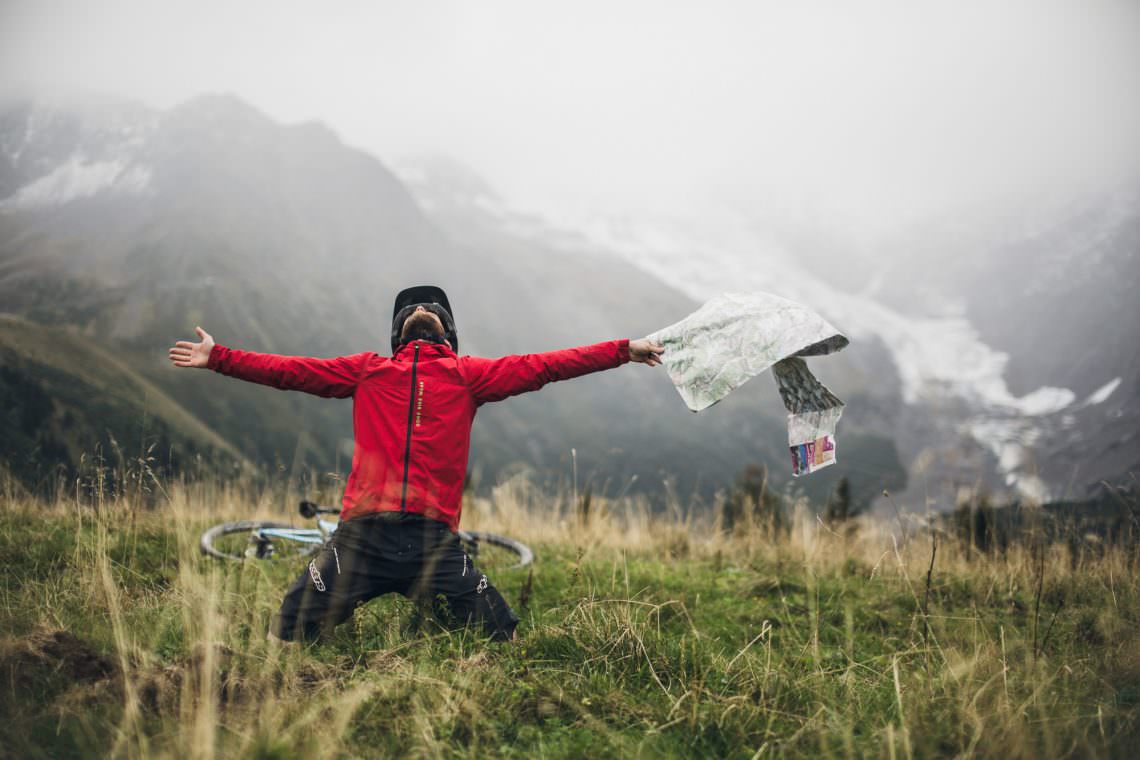
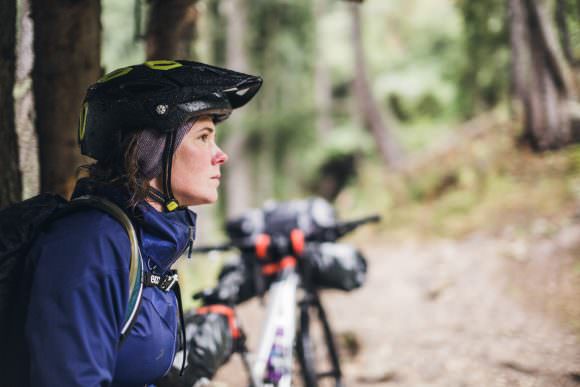

The plan had been a good one – hastily made, but a good one. We would bikepack unsupported around the Tour Du Mt Blanc (TDMB) walkers’ route, carrying everything needed to survive for 4 days. The entire network opens to bikes in September, and what a fine network it is. Overall, you’ve got a 170 km loop encircling the entire Mt Blanc mountain range, complete with 10,000 m of climbing (and descending), three countries, and many towering 2500 m passes. This was going to be so good, we were fizzing with excitement, kept awake with the thought of super-long descents. Our research had turned up very few first hand accounts – of course, the TDMB has been ridden many times and there are even commercial companies that guide the route – but there seemed to be little information stating if it were doable with full bikepacking gear, totally unsupported. Even the orientation, clockwise or anti-clockwise was a mystery, but we figured that with most walkers heading anti-clockwise, it was better to go against the grain on a bike, approaching walkers head-on rather than sneaking up behind them and risking an enraged trekking pole to the face. Clockwise it would be.
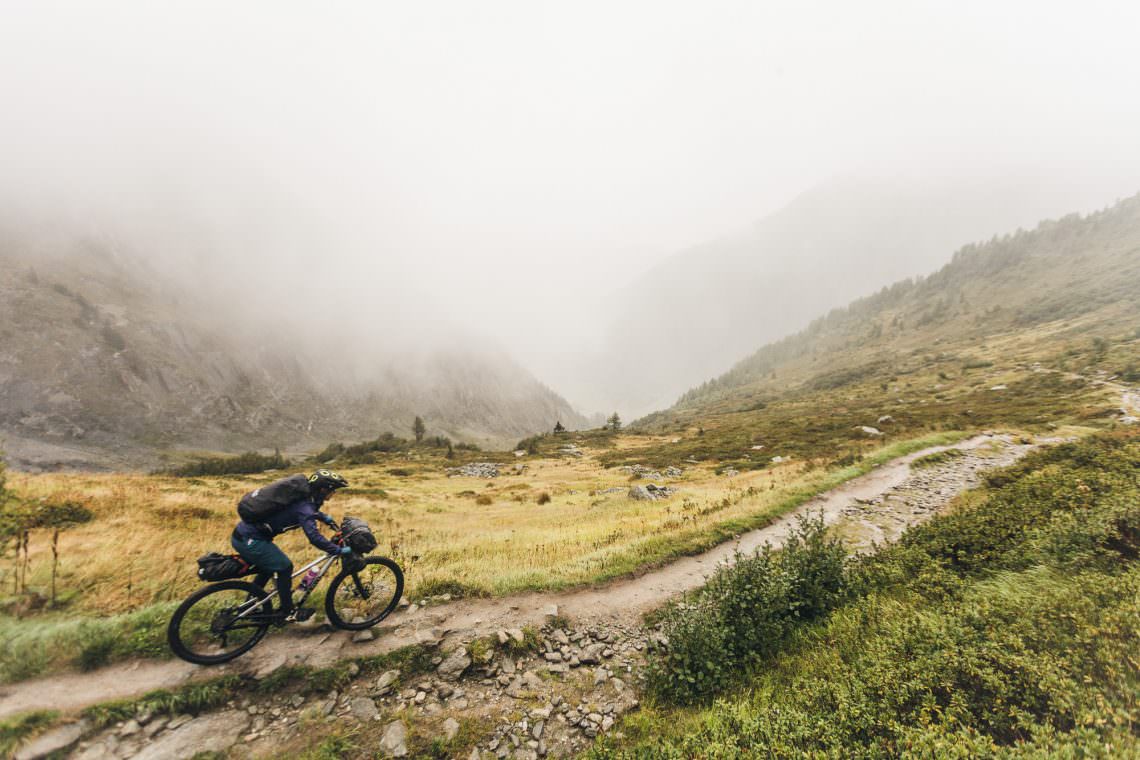
A 1:50,000 Carte De Randonnees (hiking map) duly arrived on the doorstep, the plan had become a reality, and after a quick appreciation of the incredible amount of contour lines, we traced the route around the mountain, circumnavigating the 4810 m bulk of Mt Blanc and its surrounding peaks, cutting over high mountain passes and under hanging glaciers. Now, it’s time for a confession: we are not seasoned bikepackers. I have a beard but have never killed a bear, I have never been forced to drink my own urine to stay hydrated or slept in a ditch, and as a novice, I made some big mistakes in preparation. But before we get to that, let’s look at our bike choices. Everyone knows the hardtail is the king of bikepacking, but screw that, we wanted to take some serious bikes – we were heading to the alps after all. Our selected mules would be a Pole EVO-Link 140 (certainly the longest bikepacking bike ever seen) and the awesome Marin Rift Zone 3 that had already proven its ability to punch above its weight. Alpkit and Ortlieb supplied the bikepacking bags, and we were good to rock and roll. Looking back, I do remember looking at the 1×11 drivetrains with 32-tooth chainrings and thinking, “Perhaps that will be too much… nah, it will be alright.” Mistake number one.
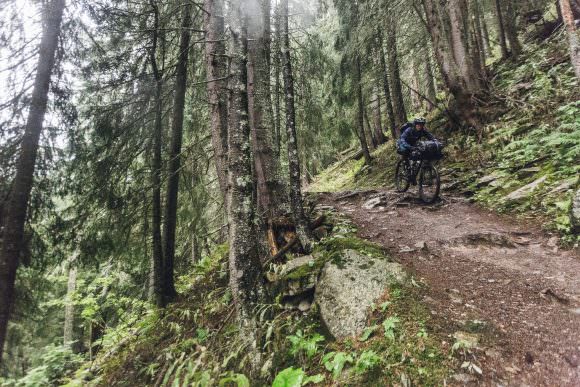


On the the map it looked so simple… sure there were a lot of contours, but how hard could it be? Now, while much of the TDMB route may well be perfectly rideable (in fact, very enjoyable) if you have unladen bikes, trained legs, and don’t mind a good dose of exposure, doing it with a large chainring, heavy bikepacking bags, and dropper posts stuck at full mast was a monumental struggle. Imagine trying to push a bad-tempered elephant up a set of stairs and you will have an idea of the relationships we formed with our bikes. Possible…yes; enjoyable… no. But push on we did, up and over the mountain passes, getting both nearer and farther from our destination. Chewing on our stems, bending our Five Tens to the hill, we often dreamt of a cold beer and dry hotel bed. It was not that we were short of incredible scenery to ease the pain, as the route was the very definition of epic. We took in ridiculously beautiful mountain vistas as we travelled from peak to valley to peak, camped in epic locations, stood on the shoulders of giants, and featured on many walkers’ Instagram feeds. We fell quickly into the pattern of sleeping ten hours a night and riding (pushing) for the rest of the day. All the time we felt the pressure of our over-ambitious four-day timescale – mistake number two – closing in on us.

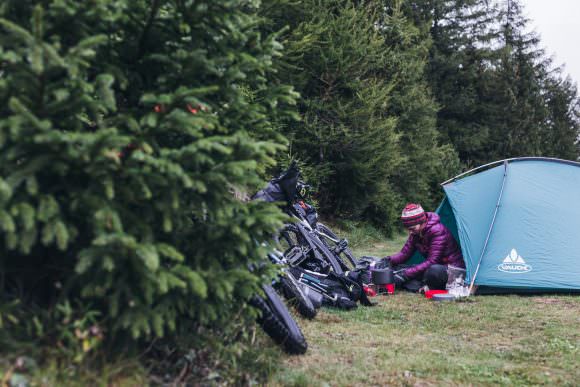
Like a roller coaster, there were highs and lows. Falling asleep to sweeping views of Mt Blanc shrouded in lenticular clouds, the warmth of the 7 € bottle of local wine battling the crisp mountain air, contrasted to waking to the sound of rain hammering off the tent and the crushing realisation that our shoes were still outside. Bikepacking is the most liberating form of travel: total freedom, carrying your home, kitchen, and bathroom (who are we kidding, we didn’t shower) on your bars, the days just feel endless. Each horizon offers new hope, with fresh perspectives from one valley to the next. We made many new friends too, all keen to stop and chat and find out why we were choosing to push our bikes up mountains, or maybe just to make sure we had not gone fully insane. We dined in sweeping valley ballrooms the rival of any Michelin-starred restaurant, and ate the finest rehydrated rice you have ever tasted. For four days we found sanctum in the church of the open sky. However, we knew we were moving too slowly.
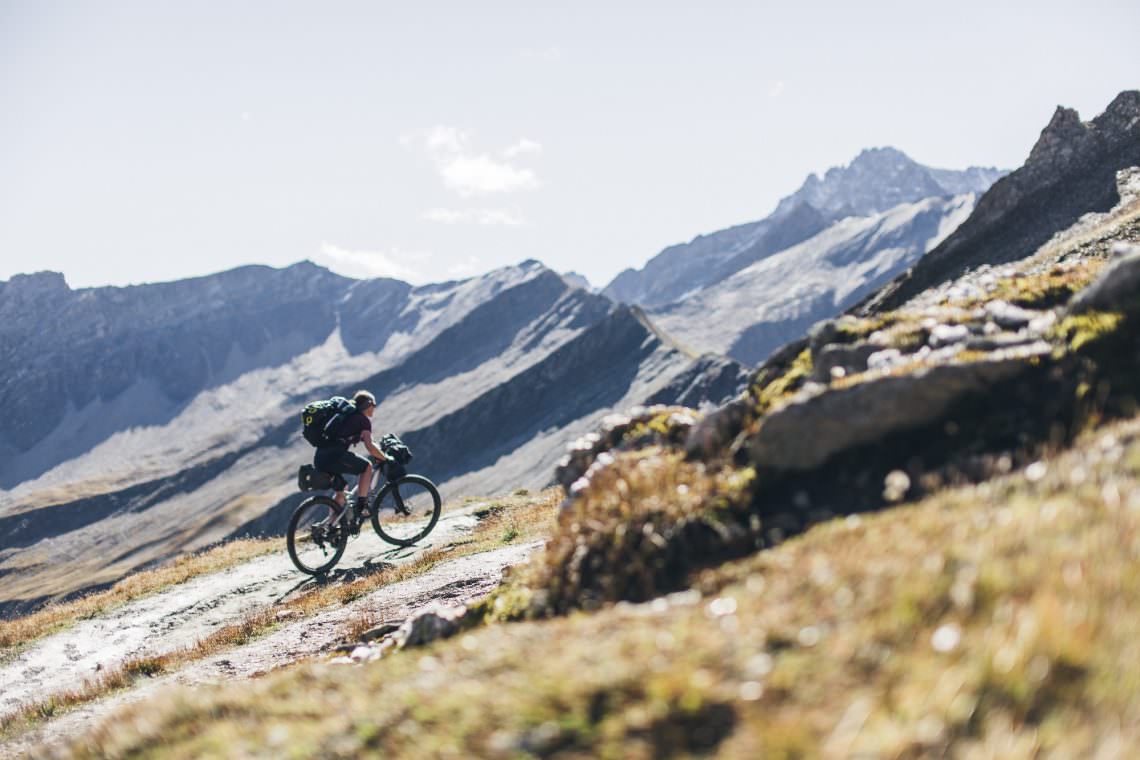
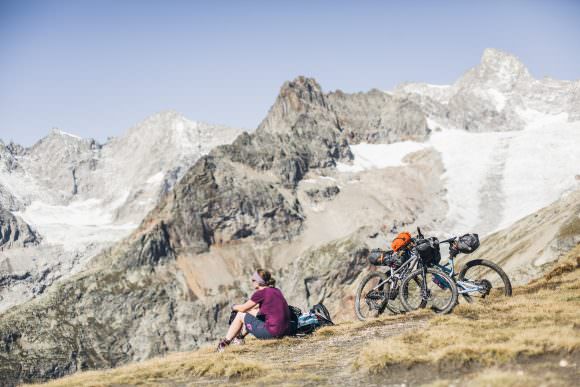



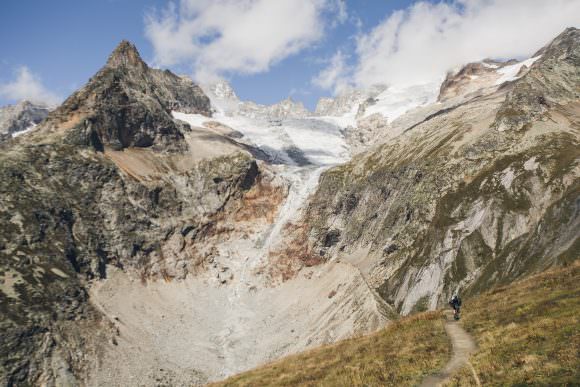
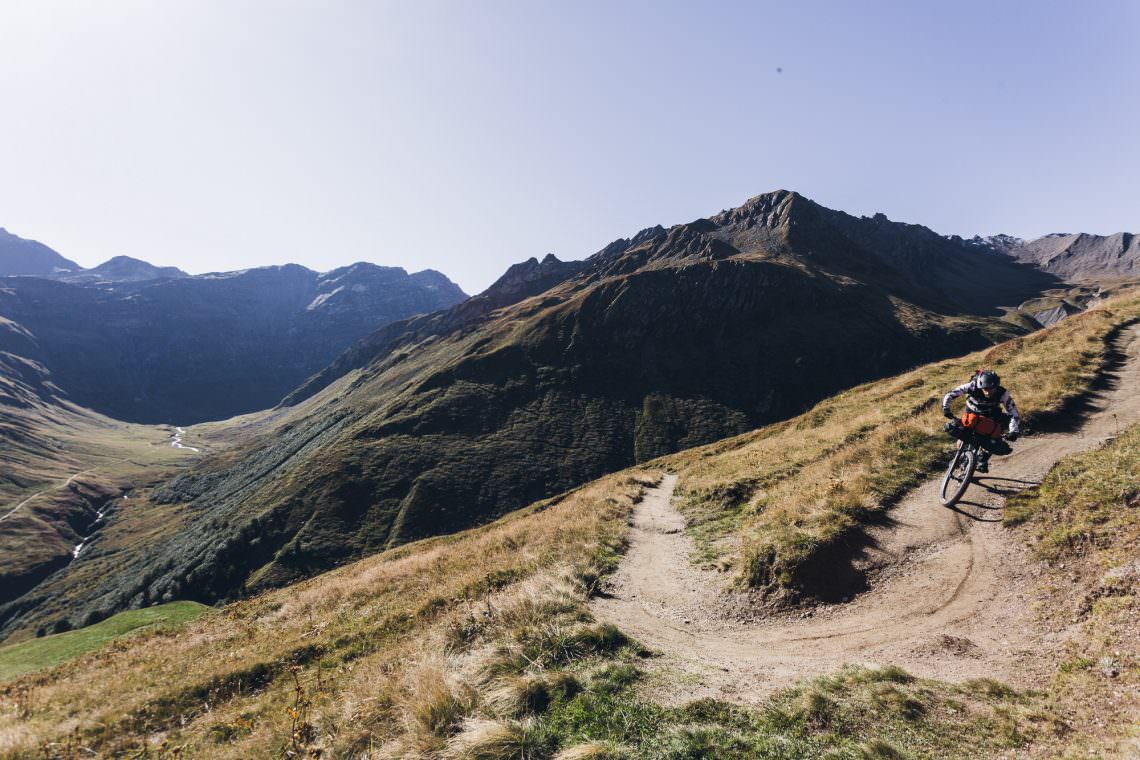
Our poor gearing meant we could not climb properly; at one point I would have happily swapped a kidney for a double drivetrain, and the heavy bags were stopping us from opening up on the descents. Seeing our time window relentlessly slipping away it was tempting to cut our losses and throw all the bikepacking gear in a skip and go for one mad, lightweight charge for the finish. Common sense (and a delicate bank balance) prevailed and after completing two-thirds of the loop, we engaged Plan B. Dropping back to Courmayeur and the SAVDA bus station (after a brief burst of panic when the mighty Pole EVO Link would not fit into the tiny bus hold), we zoomed back through the Mt Blanc Tunnel, cutting out a number of 2500 m peaks and putting us back on the right side of the mountain for our transfer back to the airport. Plan B was a success, but we had also failed. We didn’t care though – we had tried, we had lived our story, and not every story has to end in success. It had been a thrill ride of emotions, some elating, some exhilarating, and some just brutally exhausting. We had looked under the skirt of Mt Blanc and seen its beauty, we had travelled under hanging glaciers, and upon leaving the 2490m Grand Col Ferret, bags bouncing wildly as we careened down the exposed mountain track, had caused one American hiker to excitedly shout, “Well, that’s just about the craziest thing I have ever seen.” Hell, that’s enough for us.
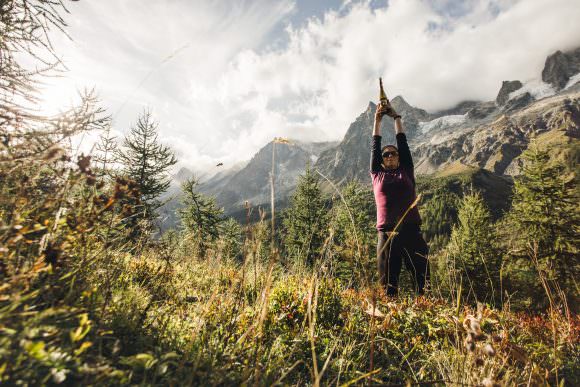

Five commandments on how not to suck at bikepacking
1. Use proper gearing. If you’re heading to the Alps with heavy bags, a 2x or Eagle drivetrain is essential. Our 32 x 44 ratio was simply purgatory on the steep climbs – at first melting our legs, then our resolve.
2. Pack only what you need. It may sound simple, but it’s amazing how little you can survive with when drilling down to the essentials. Double-check your inventory too; we discovered when unpacking that we had both lugged about a kilogram of porridge oats up and down the mountains.
3. Learn the lingo. Learn how to say, “No, we’re not lost and really do mean to be pushing up this big bastard mountain” in the native tongue. Walkers will repeatedly question you, worried for your mental health.
4. Be sure to pack a big sense of humour. When you are dragging your bike up a rocky gully in the rain, two hours from the top (and possibly a push down), it really will be all you have.
5. Get the best bags you can. When bikepacking in big mountains, good kit can make the difference between an epic trip and grounds for divorce. The Ortlieb bags we used were impressively stable in use – recommended.
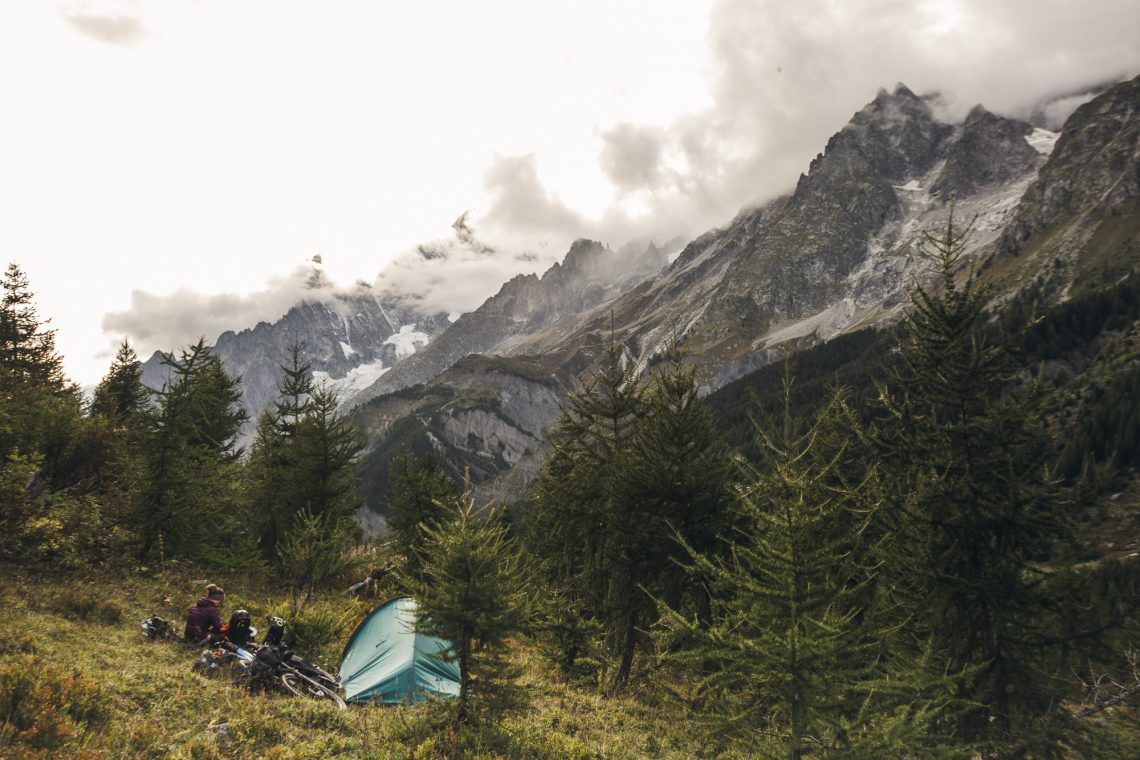

If you are the sort of person who enjoys the sadistic pleasure of self-flagellation, then you would certainly love carrying full gear around the TDMB loop. But while it’s certainly possible to ride the loop unsupported, the best way would be alpinist style. Lightweight, credit card in hand, just a backpack and staying in the incredible mountain refuges or dropping into hotels in the valley would be an incredible experience. With our heavy setup and foolish gearing, the Alps made us their bitch, but with an unladen 160 mm bike and a dropper you could ride most of the circuit, a real mountain adventure. We will be back, we will try again… but first we must wait until the nightmares subside.
What’s in the bags
Bar Bag 1
- Tent
- Sleeping mat
Bar Bag 2
- Sleeping bag
- Down jacket
- 1 x spare riding kit
- Waterproof jacket
Tail bag
- MSR Stove
- Cook set (once was non-stick)
- Folding knife in case of bears
- Compass
- Three-day food supply
- Aeropress, coffee, and powdered milk
- Enough oats to feed an army
- Spare tube, tools, duct tape
- Corkscrew (don’t go to France without one)
Water bottle 1
- Water
Water bottle 2
- Stove fuel (does not taste good)
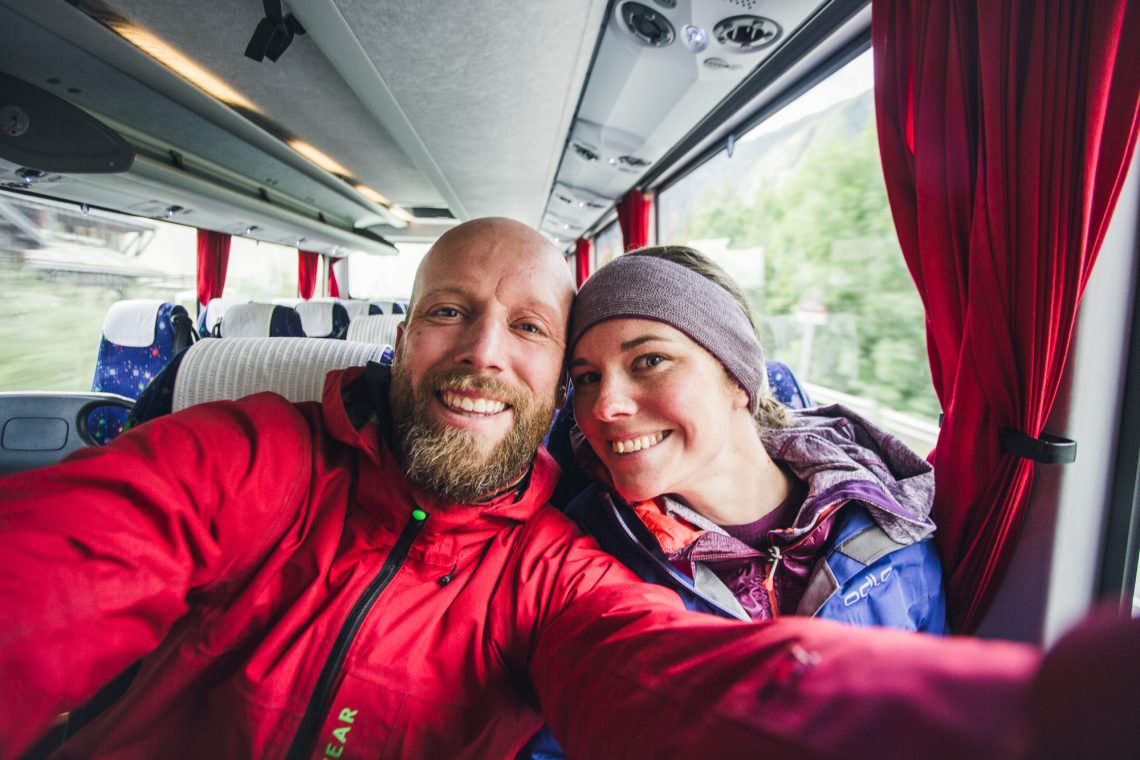

Did you enjoy this article? If so, we would be stoked if you decide to support us with a monthly contribution. By becoming a supporter of ENDURO, you will help secure a sustainable future for high-quality mountain bike journalism. Click here to learn more.
Words & Photos:












